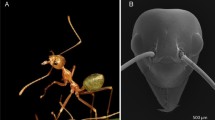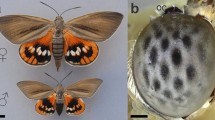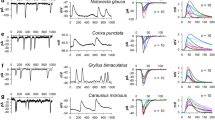Summary
-
1.
The compound eyes of three species ofCamponotus ants, one exclusively nocturnal (Camponotus irritans), one crepuscular and nocturnal (Camponotus ligniperda), and the third diurnal (Camponotus detritus) are compared with respect to day/night light sensitivity changes. AsCamponotus detritus sometimes stays outside the nest during the night, the strictly diurnal speciesCataglyphis bicolor is included in the comparison. Even though all four species are of about the same body size, the eyes of the diurnal species are much larger, contain more ommatidia and exhibit smaller cross-sectional areas of the cone tips than those of the nocturnal species.
-
2.
During the natural light/dark cycle distinct ultrastructural changes occur in the distal parts of the ommatidia in all three species ofCamponotus, whereas inCataglyphis the ommatidial structures remain unchanged throughout day and night. In the eyes of theCamponotus species the most characteristic feature of the light-adapted ommatidium is the elongated proximal part of the crystalline cone, the narrow cone tract. In addition the length of the rhabdom is shorter (by about 10 μm) than in the dark-adapted state. At night the conical cone tapers steadily from its distal end at the corneal lens to the tip of the rhabdom. These dynamic responses represent the first description of retinomotoric changes within a eucone dioptric apparatus of insect apposition eyes.
-
3.
The ommatidial dynamics occurring inCamponotus eyes take the following daily course: At dawn and dusk the retinomotoric changes require almost 2 h of the natural daily light cycle. As demonstrated by artificial light regimes they are based on an endogenous circadian rhythm.
-
4.
Results obtained from electrophysiological (ERG) recordings are in accord with the anatomical findings. InCataglyphis bicolor the ERG-responses do not show any daily sensitivity changes, whereasCamponotus ligniperda exhibits a distinct circadian modulation of compound eye sensitivity. Between the light- and dark-adapted state sensitivity varies by about 1 log unit.
Similar content being viewed by others
References
Barlow RB, Bolanowski SJ, Brachman ML (1977) Efferent optic nerve fibers mediate circadian rhythms in theLimulus eye. Science 197:86–89
Battelle B-A, Evans JA, Chamberlain SC (1982) Efferent fibers toLimulus eye synthesize and release octopamine. Science 216:1250–1252
Blest AD (1980) Photoreceptor membrane turnover in arthropods: comparative studies of breakdown processes and their implications. In: Williams TP, Baker BN (eds) The effects of constant light on visual processes. Plenum, New York London, pp 217–245
Curtis BA (1985) Temperature tolerances in the Namib desert dune ant,Camponotus detritus. J Insect Physiol 31:463–466
Eckert M (1968) Hell-Dunkel Adaptation in aconen Appositionsaugen. Zool Jb Physiol 74:102–120
Fein A, Charlton JS (1977) A quantitative comparison of the effects of the photoresponse ofLimulus ventral photoreceptors. J Gen Physiol 70:591–600
Fleissner G (1974) Circadiane Adaptation und Schirmpigment-verlagerung in den Sehzellen der Medianaugen vonAndroctonus australis L. (Buthidae, Scorpiones). J Comp Physiol 91:399–416
Fleissner G, Fleissner G (1978) The optic nerve mediates the circadian pigment migration in the eyes of the scorpion. Comp Biochem Physiol A 61:69–71
Grenacher H (1879) Untersuchungen über das Sehorgan der Arthropoden, insbesondere der Spinnen, Insekten und Crustaceen. Vandenhoeck & Ruprecht, Göttingen
Herrling PL (1975) Topographische Untersuchungen zur funktionellen Anatomie der Retina vonCataglyphis bicolor (Formicidae, Hymenoptera). Dissertation, Universität Zürich
Home EM (1975) Ultrastructural studies of development and light-dark adaptation of the eye ofCoccinella septempunctata L., with particular reference to ciliary structures. Tissue Cell 7:703–722
Horridge GA (1969) Unit studies on the retina of dragonflies. Z Vergl Physiol 62:1–37
Horridge GA, Giddings C (1971) The retina ofEphestia (Lepidoptera). Proc R Soc Lond B 179:87–95
Horridge GA, Marcelja FRS L, Jahnke R, McIntyre P (1983) Daily changes in the compound eye of a beetle (Macrogyrus). Proc R Soc Lond B 217:265–285
Hurley AC, Lange GD, Hartline PH (1978) The adjustible ‘pinehole camera’ eyeof Nautilus. J Exp Zool 205:37–44
Jahn T, Wulff VJ (1943) Electrical aspects of a diurnal rhythm in the eye ofDytiscus fasciventris. Physiol Zool 16:101–109
Kass L, Barlow RB (1980) Octopamine increases the ERG ofLimulus lateral eye. Biol Bull 159:487
Kass L, Barlow RB (1984) Efferent neurotransmission of the circadian rhythms inLimulus lateral eye. J Neurosci 4:908–917
Kirschfeld F, Franceschini N (1969) Ein Mechanismus zur Steuerung des Lichtflusses in den Rhabdomeren des Komplexauges vonMusca. Kybernetik 6:13–22
Kleinholz LH (1966) Hormonal regulation of migration in crustaceans. In: Bernhard CG (ed) The functional organization of the compound eye. Pergamon, Oxford, pp 89–101
Kunze P (1979) Apposition and superposition eyes. In: Autrum H (ed) Vision in invertebrates (Handbook of sensory physiology, vol VII/6A). Springer, Berlin Heidelberg New York, pp 441–502
Laughlin BS (1981) Neuronal principles in the visual system. In: Autrum H (ed) Vision in invertebrates (Handbook of sensory physiology, vol VII/6B). Springer, Berlin Heidelberg New York, pp 133–280
Lüdtke H (1953) Retinomotorik und Adaptationsvorgänge im Auge des Rückenschwimmers (Notonecta glauca). Z Vergl Physiol 35:129–152
Meyer-Rochow VB (1972) The eyes ofCreophilus erythrocephalus F. andSartallus signatus Sharp (Staphylinidae: Coleoptera). Z Zellforsch 133:59–86
Miller WH (1979) Intraocular filters. In: Autrum H (ed) Vision in invertebrates (Handbook of sensory physiology vol VII/ 6A). Springer, Berlin Heidelberg New York, pp 69–143
Muller LL, Jacks TJ (1975) Rapid chemical dehydration of samples for electron microscopic examination. J Histochem Cytochem 23:107–110
RCA (1968) Electro-optics handbook. RCA. Harrison, New Jersey
Sato S, Kato M, Toriumi M (1957) Structural changes of the compound eye ofCulex pipiens var.pallens Coquillett in the process to dark adaptation. Sci Rep Tohoku Univ (IV) 23:91–100
Snyder AW (1979) Physics of vision in compound eyes. In: Autrum H (ed) Vision in invertebrates (Handbook of sensory physiology vol VII/6 A). Springer, Berlin Heidelberg New York, pp 225–313
Sotavalta O, Tuurala O, Oura A (1962) On the structure and photomechanical reactions of the compound eyes of craneflies (Tipulidae; Limnobiidae). Ann Acad Sci Fen Ser A 62:1–14
Stieve H, Bruns M, Gaube H (1977) Ability to light-induced conductance change of arthropod visual cell membrane, indirectly depending on membrane potential, during depolarisation by external potassium or ouabain. Z Naturforsch 32c:855–869
Swihart SL (1963) The electroretinogram ofHeliconius erato (Leptidoptera). Zoologica 48:155–166
Varela FG, Wiitanen W (1970) The optics of the compound eye of the honeybee (Apis mellifera). J Gen Physiol 55:336–358
Ventura DF, Martinoya C, Bloch S, Puglia NM (1976) Visual sensitivity and the state of adaptation in the antAtta sexdens (Hymenoptera; Formicoidea). J Comp Physiol 110:333–342
Wada S, Schneider G (1967) Eine Pupillenreaktion im Ommatidium vonTenebrio molitor. Naturwissenschaften 54:542
Wada S, Schneider G (1968) Circadianer Rhythmus der Pupillenweite im Ommatidium vonTenebrio molitor. Z Vergl Physiol 58:395–397
Walcott B (1971a) Cell movement on light adaptation in the retina ofLethocerus (Belastomatidae, Hemiptera). Z Vergl Physiol 74:1–16
Walcott B (1971b) Unit studies on receptor movement in the retina ofLethocerus (Belostomatidae, Hemiptera). Z Vergl Physiol 74:17–25
Walcott B (1975) Anatomical changes during light adaptation in insect compound eyes. In: Horridge GA (ed) The compound eye and vision of insects. Oxford University Press, London, pp 20–33
Wehner R (1981) Comparative physiology and evolution of vision in invertebrates. In: Autrum H (ed) Vision in invertebrates (Handbook of sensory physiology, vol VII/6C). Springer, Berlin Heidelberg New York, pp 287–616
Wehner R, Harkness RD, Schmid-Hempel P (1983) Foraging strategies in individually searching ants. Akad Wiss Literatur Mainz, G Fischer Verlag, Stuttgart New York, pp 20f
White RH, Gifford D, Michaud NA (1980) Turnover of photoreceptor membrane in the larval mosquito ocellus: rhabdomeric coated vesicles and organelles of the vacuolar system. In: Williams TP, Baker BN (eds) The effects of constant light on visual processes. Plenum Plublishing Corporation, New York London, pp 271–296
Williams DS (1980) Organisation of the compound eye of a tipulid fly during day and night. Zoomorphol 95:85–104
Author information
Authors and Affiliations
Rights and permissions
About this article
Cite this article
Menzi, U. Visual adaptation in nocturnal and diurnal ants. J. Comp. Physiol. 160, 11–21 (1987). https://doi.org/10.1007/BF00613437
Accepted:
Issue Date:
DOI: https://doi.org/10.1007/BF00613437




